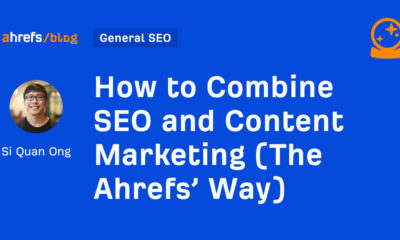SEO
15 Top Digital Marketing Tools & Why We Love Them

The digital marketing industry is constantly changing, and if you feel like you’re being challenged to do more with less, you’re not alone.
Marketers need tools more than ever to automate repetitive tasks, augment our skills, collaborate more effectively, and scale what we’re doing right.
And when it comes to digital marketing tools, you have tens or even hundreds of thousands of options to choose from – certainly hundreds of options for each channel or task type.
Here are 15 of the most popular digital marketing tools on the market right now (in no particular order) and why they’re indispensable to many.
1. Canva
Steve Jobs once said, “Simplicity is the ultimate sophistication.”
Canva makes creating design elements simple with a sophisticated platform.
If you can not draw a stick figure, don’t worry. The Canva repository of designs allows you to choose and edit a design without specific skills to create a stunning pixel-perfect design.
Additionally, Canva provides graphic animation, infographics, and videos.
Canva offers a free plan, but if you want to upgrade to a paid plan, it is well worth the investment.
2. HubSpot
HubSpot provides a powerhouse of tools to help marketers, but the Hubspot CRM is particularly popular due to its powerful features.
The HubSpot CRM provides email tracking & notifications, prospect tracking, meeting scheduling, and a live chat option.
Furthermore, HubSpot’s ease of use makes the platform stand out from competitors.
The best part about the HubSpot CRM tool is the price point, which is free.
Unfortunately, the drawback of the free plan is that it only allows two users to access the CRM.
However, the paid plan has unlimited users, and you can add up to one million contacts.
3. VWO
Conversion rate optimization (CRO) can be somewhat esoteric, but it doesn’t have to be with VWO (Visual Web Optimizer).
VWO measures clicks on-site, page scrolling from users, time spent on site, and exit intent.
The power of VWO is the ability to test different angles for your site to increase your conversion rates.
Testing button colors, headlines, landing page layouts, and several other variables is straightforward with VWO.
You don’t have to be technically inclined to set up tests.
Non-technically inclined individuals without coding skills can set up tests just as easily as a developer.
4. Semrush
To drive traffic to your site, you will need competitive intelligence.
Semrush provides 50+ tools to help you compete against your competitors.
Semrush is widely regarded as an SEO tool, but that may be selling it a bit short as the software offers several other digital marketing features.
For instance, Semrush offers features for social media competitive analysis, CRO, PPC spying, and PR monitoring.
If you’re looking for a suite of tools to compete against the onslaught of competitors looking to drive you out of business, Semrush provides a good line of defense.
5. Slack
Once upon a time, carrier pigeons, smoke signals, and letters were the norm for communication.
Now, millions of people use Slack as the primary way of communicating.
Slack is the next evolution of communication. Messages are instantaneous, and you can share several file formats through the platform.
Additionally, Slack connects you to video conference calls and allows you to create channels for a select group of contacts for group chatting to increase productivity.
It also integrates well with various other tools and productivity suites.
6. Asana
The path of least resistance is not always a linear progression.
Asana realized this when they built this fantastic project management software.
Asana provides project managers, product managers, and executives visibility and accountability of team members.
You can break tasks down into subtasks and assign them to team members.
Additionally, you can set up milestones, and the entire organization can view the progression of projects through tagging tasks.
Through API integrations, Asana also integrates with CRM systems and several other third-party apps.
Furthermore, you can start to use Asana for free.
7. OptinMonster
OptinMonster, bought to you by veteran WordPress aficionado Syed Balkhi, is sure to delight.
Whether you are a startup, small business, or even an enterprise-level organization with a WordPress site or blog, OptinMonster monster delivers advanced functionality hidden in simplicity to end-users.
OptinMonster provides a highly customizable lightbox popup for collecting emails, countdown timers, inline forms, content locks, and targeted campaigns based on Google Analytics data that seamlessly integrates with the platform.
8. ConvertKit
ConvertKit provides advanced multi-step email journeys called sequences to increase your email open rates.
In addition, audience segmentation called rules within the platform offers complex automation for your email sequences which take minutes, not hours, to build with ConvertKit.
Furthermore, all links inserted within your email sequences are tracked and reported within a user-friendly dashboard.
ConvertKit also enables you to copy and paste code within your articles to create beautiful email opt-in forms that can easily integrate with the CRM platform of your choice.
If you are looking for a cost-effective, user-friendly email marketing software that provides advanced automation and segmentation with a plethora of API integrations, try ConvertKit.
9. Unbounce
Landing pages can make or break the number of transactions you can drive to your organization.
For instance, if you are running PPC campaigns, Google ads assign a landing page quality score that could either help or hurt your efforts to drive sales.
Unbounce provides a cost-effective way to build responsive landing pages optimized for mobile and desktop traffic that happen to be aesthetically pleasing and functional.
No coding is necessary to create landing pages.
The drag and drop editor provides you with everything you need to make the experience you would like to create for your target audience.
If you would like to add advanced functionality, you have the option of adding custom HTML and Javascript.
Unbounce offers over 120 integrations with third-party applications.
AI technology called smart traffic can dynamically shift your traffic to the highest converting landing page variant, drastically increasing your conversion rates.
10. Buzzsumo
Buzzsumo is a social media tool that has taken the marketing world by storm since its inception by seasoned marketer Noah Kagan.
When you need a tool to get to the heart of social media analytics, look no further.
Identifying social media influencers, building trending journalist profiles, and viewing the most shared content are a few features that Buzzsumo offers that will give you a competitive advantage against your competitors.
11. Sprout Social
Have you ever needed to be in multiple places at one time?
Sprout Social gives you the ability to post to multiple social media platforms by automating your social media stories.
The best feature about Sprout Social is the analytics dashboard to gauge activity across each social channel once you have automated your posts.
Sprout Social is a no-brainer to add to your tech stack if you have multiple social media channels.
12. Deepcrawl
Deepcrawl enables you to gather impactful metrics – and fast.
In addition, unlike several other technical SEO web crawlers, a clean user interface makes navigating the platform straightforward.
Deepcrawl makes automated SEO crawls and automated code audits seamless.
Furthermore, the platform offers a strategic partner to help you unlock all the powerful features of the platform.
13. Demio
Did you know nearly 70% of webinars are for increasing sales and engagement?
If you are not leveraging webinars, you are seriously leaving money on the table for your organization.
Demio is a powerful tool that hosts live events and conducts product overviews.
Furthermore, Demio evergreen webinars that can increase your participation rate.
As a marketer in the 21st century, you are aware of the power of video – but personalization is critical now more than ever.
Personalization with video is accomplished with Loom.
You can present a video recording or live video while displaying your face in a small circular box that is non-intrusive and sleek.
Loom is excellent for teaching students, providing general overviews and software product walkthroughs.
Fun fact: The SEJ team uses Loom internally.
15. Lucky Orange
Lucky Orange provides eight tools under one company umbrella.
Simply put, this platform is the closest match to a digital marketing Swiss army knife.
One monthly flat rate provides access to the following tools:
- Heat mapping.
- Video recording sessions.
- Live chatbox.
- Conversion funnel analysis.
- Visitor profiles.
- Pop up announcements.
- User surveys.
- Dashboard analytics.
Guess how much it costs for the starter plan?
Drum roll, please.
Plans start at $10 a month.
Startup founders, established business owners, or anyone with a web presence can gather a deeper understanding of your audience with Lucky Orange.
Google Analytics is always a go-to but take your analytics analysis further with this affordable and versatile tool.
In Conclusion
No matter what digital marketing niche you operate in, automating your marketing efforts is the current reality.
These 15 tools can help automate specific tasks, save you time, and ultimately generate more revenue for your organization.
If you are a startup founder, blogger, or internet-based small business, consider integrating these tools into your tech stack.
More resources:
Featured Image: jossnat/Shutterstock
SEO
Google Cautions On Blocking GoogleOther Bot

Google’s Gary Illyes answered a question about the non-search features that the GoogleOther crawler supports, then added a caution about the consequences of blocking GoogleOther.
What Is GoogleOther?
GoogleOther is a generic crawler created by Google for the various purposes that fall outside of those of bots that specialize for Search, Ads, Video, Images, News, Desktop and Mobile. It can be used by internal teams at Google for research and development in relation to various products.
The official description of GoogleOther is:
“GoogleOther is the generic crawler that may be used by various product teams for fetching publicly accessible content from sites. For example, it may be used for one-off crawls for internal research and development.”
Something that may be surprising is that there are actually three kinds of GoogleOther crawlers.
Three Kinds Of GoogleOther Crawlers
- GoogleOther
Generic crawler for public URLs - GoogleOther-Image
Optimized to crawl public image URLs - GoogleOther-Video
Optimized to crawl public video URLs
All three GoogleOther crawlers can be used for research and development purposes. That’s just one purpose that Google publicly acknowledges that all three versions of GoogleOther could be used for.
What Non-Search Features Does GoogleOther Support?
Google doesn’t say what specific non-search features GoogleOther supports, probably because it doesn’t really “support” a specific feature. It exists for research and development crawling which could be in support of a new product or an improvement in a current product, it’s a highly open and generic purpose.
This is the question asked that Gary narrated:
“What non-search features does GoogleOther crawling support?”
Gary Illyes answered:
“This is a very topical question, and I think it is a very good question. Besides what’s in the public I don’t have more to share.
GoogleOther is the generic crawler that may be used by various product teams for fetching publicly accessible content from sites. For example, it may be used for one-off crawls for internal research and development.
Historically Googlebot was used for this, but that kind of makes things murky and less transparent, so we launched GoogleOther so you have better controls over what your site is crawled for.
That said GoogleOther is not tied to a single product, so opting out of GoogleOther crawling might affect a wide range of things across the Google universe; alas, not Search, search is only Googlebot.”
It Might Affect A Wide Range Of Things
Gary is clear that blocking GoogleOther wouldn’t have an affect on Google Search because Googlebot is the crawler used for indexing content. So if blocking any of the three versions of GoogleOther is something a site owner wants to do, then it should be okay to do that without a negative effect on search rankings.
But Gary also cautioned about the outcome that blocking GoogleOther, saying that it would have an effect on other products and services across Google. He didn’t state which other products it could affect nor did he elaborate on the pros or cons of blocking GoogleOther.
Pros And Cons Of Blocking GoogleOther
Whether or not to block GoogleOther doesn’t necessarily have a straightforward answer. There are several considerations to whether doing that makes sense.
Pros
Inclusion in research for a future Google product that’s related to search (maps, shopping, images, a new feature in search) could be useful. It might be helpful to have a site included in that kind of research because it might be used for testing something good for a site and be one of the few sites chosen to test a feature that could increase earnings for a site.
Another consideration is that blocking GoogleOther to save on server resources is not necessarily a valid reason because GoogleOther doesn’t seem to crawl so often that it makes a noticeable impact.
If blocking Google from using site content for AI is a concern then blocking GoogleOther will have no impact on that at all. GoogleOther has nothing to do with crawling for Google Gemini apps or Vertex AI, including any future products that will be used for training associated language models. The bot for that specific use case is Google-Extended.
Cons
On the other hand it might not be helpful to allow GoogleOther if it’s being used to test something related to fighting spam and there’s something the site has to hide.
It’s possible that a site owner might not want to participate if GoogleOther comes crawling for market research or for training machine learning models (for internal purposes) that are unrelated to public-facing products like Gemini and Vertex.
Allowing GoogleOther to crawl a site for unknown purposes is like giving Google a blank check to use your site data in any way they see fit outside of training public-facing LLMs or purposes related to named bots like GoogleBot.
Takeaway
Should you block GoogleOther? It’s a coin toss. There are possible potential benefits but in general there isn’t enough information to make an informed decision.
Listen to the Google SEO Office Hours podcast at the 1:30 minute mark:
Featured Image by Shutterstock/Cast Of Thousands
SEO
AI Search Boosts User Satisfaction

A new study finds that despite concerns about AI in online services, users are more satisfied with search engines and social media platforms than before.
The American Customer Satisfaction Index (ACSI) conducted its annual survey of search and social media users, finding that satisfaction has either held steady or improved.
This comes at a time when major tech companies are heavily investing in AI to enhance their services.
Search Engine Satisfaction Holds Strong
Google, Bing, and other search engines have rapidly integrated AI features into their platforms over the past year. While critics have raised concerns about potential negative impacts, the ACSI study suggests users are responding positively.
Google maintains its position as the most satisfying search engine with an ACSI score of 81, up 1% from last year. Users particularly appreciate its AI-powered features.
Interestingly, Bing and Yahoo! have seen notable improvements in user satisfaction, notching 3% gains to reach scores of 77 and 76, respectively. These are their highest ACSI scores in over a decade, likely due to their AI enhancements launched in 2023.
The study hints at the potential of new AI-enabled search functionality to drive further improvements in the customer experience. Bing has seen its market share improve by small but notable margins, rising from 6.35% in the first quarter of 2023 to 7.87% in Q1 2024.
Customer Experience Improvements
The ACSI study shows improvements across nearly all benchmarks of the customer experience for search engines. Notable areas of improvement include:
- Ease of navigation
- Ease of using the site on different devices
- Loading speed performance and reliability
- Variety of services and information
- Freshness of content
These improvements suggest that AI enhancements positively impact various aspects of the search experience.
Social Media Sees Modest Gains
For the third year in a row, user satisfaction with social media platforms is on the rise, increasing 1% to an ACSI score of 74.
TikTok has emerged as the new industry leader among major sites, edging past YouTube with a score of 78. This underscores the platform’s effective use of AI-driven content recommendations.
Meta’s Facebook and Instagram have also seen significant improvements in user satisfaction, showing 3-point gains. While Facebook remains near the bottom of the industry at 69, Instagram’s score of 76 puts it within striking distance of the leaders.
Challenges Remain
Despite improvements, the study highlights ongoing privacy and advertising challenges for search engines and social media platforms. Privacy ratings for search engines remain relatively low but steady at 79, while social media platforms score even lower at 73.
Advertising experiences emerge as a key differentiator between higher- and lower-satisfaction brands, particularly in social media. New ACSI benchmarks reveal user concerns about advertising content’s trustworthiness and personal relevance.
Why This Matters For SEO Professionals
This study provides an independent perspective on how users are responding to the AI push in online services. For SEO professionals, these findings suggest that:
- AI-enhanced search features resonate with users, potentially changing search behavior and expectations.
- The improving satisfaction with alternative search engines like Bing may lead to a more diverse search landscape.
- The continued importance of factors like content freshness and site performance in user satisfaction aligns with long-standing SEO best practices.
As AI becomes more integrated into our online experiences, SEO strategies may need to adapt to changing user preferences.
Featured Image: kate3155/Shutterstock
SEO
Google To Upgrade All Retailers To New Merchant Center By September

Google has announced plans to transition all retailers to its updated Merchant Center platform by September.
This move will affect e-commerce businesses globally and comes ahead of the holiday shopping season.
The Merchant Center is a tool for online retailers to manage how their products appear across Google’s shopping services.
Key Changes & Features
The new Merchant Center includes several significant updates.
Product Studio
An AI-powered tool for content creation. Google reports that 80% of current users view it as improving efficiency.
This feature allows retailers to generate tailored product assets, animate still images, and modify existing product images to match brand aesthetics.
It also simplifies tasks like background removal and image resolution enhancement.
Centralized Analytics
A new tab consolidating various business insights, including pricing data and competitive analysis tools.
Retailers can access pricing recommendations, competitive visibility reports, and retail-specific search trends, enabling them to make data-driven decisions and capitalize on popular product categories.
Redesigned Navigation
Google claims the new interface is more intuitive and cites increased setup success rates for new merchants.
The platform now offers simplified website verification processes and can pre-populate product information during setup.
Initial User Response
According to Google, early adopters have shown increased engagement with the platform.
The company reports a 25% increase in omnichannel merchants adding product offers in the new system. However, these figures have yet to be independently verified.
Jeff Harrell, Google’s Senior Director of Merchant Shopping, states in an announcement:
“We’ve seen a significant increase in retention and engagement among existing online merchants who have moved to the new Merchant Center.”
Potential Challenges and Support
While Google emphasizes the upgrade’s benefits, some retailers, particularly those comfortable with the current version, may face challenges adapting to the new system.
The upgrade’s mandatory nature could raise concerns among users who prefer the existing interface or have integrated workflows based on the current system.
To address these concerns, Google has stated that it will provide resources and support to help with the transition. This includes tutorial videos, detailed documentation, and access to customer support teams for troubleshooting.
Industry Context
This update comes as e-commerce platforms evolve, with major players like Amazon and Shopify enhancing their seller tools. Google’s move is part of broader efforts to maintain competitiveness in the e-commerce services sector.
The upgrade could impact consumers by improving product listings and providing more accurate information across Google’s shopping services.
For the e-commerce industry as a whole, it signals a continued push towards AI-driven tools and data-centric decision-making.
Transition Timeline
Google states that retailers will be automatically upgraded by September if they still need to transition.
The company advises users to familiarize themselves with the new features before the busy holiday shopping period.
Featured Image: BestForBest/Shutterstock
-

 SEARCHENGINES5 days ago
SEARCHENGINES5 days agoBillions Of Google goo.gl URLs To 404 In The Future
-

 SEO7 days ago
SEO7 days ago26 Common SEO Myths, Debunked
-
SEARCHENGINES4 days ago
Daily Search Forum Recap: July 22, 2024
-

 SEARCHENGINES6 days ago
SEARCHENGINES6 days agoGoogle Core Update Coming, Ranking Volatility, Bye Search Notes, AI Overviews, Ads & More
-

 SEO5 days ago
SEO5 days ago11 Copyscape Alternatives To Check Plagiarism
-

 SEO6 days ago
SEO6 days agoGoogle Warns Of Last Chance To Export Notes Search Data
-

 AFFILIATE MARKETING5 days ago
AFFILIATE MARKETING5 days agoThe Top 5 AI Tools That Can Revolutionize Your Workflow and Boost Productivity
-
SEARCHENGINES3 days ago
Daily Search Forum Recap: July 23, 2024














You must be logged in to post a comment Login